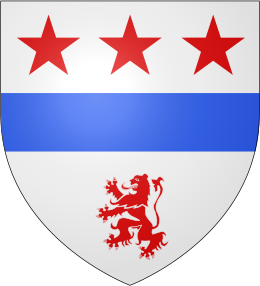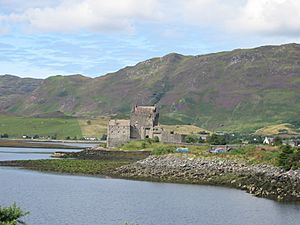Clan Macrae facts for kids
Quick facts for kids Clan MacRae |
|||
|---|---|---|---|

Crest: A cubit arm grasping a sword all Proper
|
|||
| Motto | Fortitudine | ||
| Slogan | Sgùrr Uaran | ||
| Profile | |||
| Region | Scottish Highlands | ||
| District | Wester Ross Sutherland |
||
| Plant badge | Club moss | ||
 |
|||
| Clan MacRae has no chief, and is an armigerous clan | |||
| Historic seat | Eilean Donan | ||
| Last Chief | MacRae of Inverinate | ||
|
|||
|
|||
The Clan Macrae is a historic Scottish clan from the Scottish Highlands. Clans are like big families that share a common ancestor. This clan doesn't have a chief today, so it's called an armigerous clan. This means they still have a coat of arms, but no current leader.
Contents
What's in a Name?
The name Macrae comes from the Gaelic name MacRaith. It means 'son of grace'. Over time, the Gaelic name was changed to sound more English. This process is called anglicisation.
Where Did the Clan Come From?
Historians like Alexander Mackenzie and Rev. Alexander Macrae studied the clan's past. They used old writings, especially one from the late 1600s by Rev. John Macrae.
Early Stories
Tradition says the Macraes originally came from Ireland. They were believed to share ancestors with the Clan Mackenzie and Clan Maclean. The Macraes were first said to be from Clunes, near the Beauly Firth. This area was part of the Lovat lands.
Around the mid-1200s, a big argument happened between the Macraes and the powerful Clan Fraser of Lovat. Because of this, three sons of the Macrae chief left their home. One son settled near Dingwall, another in Argyll, and the third in Kintail.
Settling in Kintail
Kintail was controlled by the Mackenzies at that time. The Mackenzie chief welcomed the Macraes. This was because they were believed to share a common family background. The Macrae brother who settled in Kintail married into a local family. This marriage helped build strong loyalty between the Macraes and the Mackenzies.
Historians think these events happened in the early 1300s. This was before the Mackenzies fully controlled Kintail. It is also said that Eilean Donan Castle was guarded by Macraes and Maclennans in the late 1200s. This was when the Mackenzie clan first took over the castle.

A famous ancestor of the Kintail Macraes was Fionnla Dubh mac Gillechriosd. He lived around the same time as Murdo Mackenzie, the fifth chief of the Mackenzies. In 1416, Murdo died. His son, Alexander, became the new chief. When Alexander was young, his uncles caused trouble in the Mackenzie lands. Fionnla Dubh helped bring Alexander back from southern Scotland. With Alexander's return, peace was restored. The main line of the Macraes, the Macraes of Inverinate, are descended from Fionnla Dubh.
Clan History
The Macraes were always loyal to the Clan Mackenzie. For many years, starting in 1520, they were the guards of Eilean Donan Castle.
Defending Eilean Donan
In 1539, the Clan Macdonald of Sleat attacked Eilean Donan Castle. They wanted to bring back the old Lordship of the Isles. Duncan Macrae is famous for ending this attack. He shot the Macdonald chief with an arrow. Because of their strong loyalty, the Macraes of Kintail were known as the Mackenzies' "shirt of mail." This meant they were like a protective armor.
The 1600s and Civil War
Rev. Farquhar Macrae, born in 1580, was the Constable of Eilean Donan. He was a dedicated churchman and a great scholar of Latin. It is said that on his first visit to the Isle of Lewis, he baptized everyone under forty. This was because no clergyman had lived there for a long time. His second son, John Macrae, became a minister in Dingwall in 1640.
During the English Civil War, the Clan Macrae supported the Royalist side. They fought bravely at the Battle of Auldearn in May 1645. Later, they followed the Earl of Seaforth to support the Royalist leader, James Graham, 1st Marquess of Montrose.
Duncan Macrae of Inverinate, a grandson of Rev. Farquhar Macrae, put together the famous Fernaig manuscript. This important collection of Gaelic poetry and writings was created between 1688 and 1693.
Jacobite Risings
In 1721, a group of Ross clansmen tried to collect rents in Mackenzie lands. They were met by Colonel Donald Murchison and three hundred Mackenzies and Macraes. In the short Battle of Glen Affric, the Rosses were outnumbered and withdrew.
During the Jacobite rising of 1745, the Macraes were split. Some Macraes joined the Jacobites. Others joined the government's Independent Highland Companies. In June 1746, over sixty Macraes were part of the Mackenzie Company. This included an officer named Ensign John MacRae.
American Revolution
Many Clan Macrae members had settled in North Carolina. When the American Revolution began, they fought as Loyalists. They were led by Brigadier General Donald MacDonald at the Battle of Moore's Creek Bridge.
Among them was the poet John MacRae. He is one of the earliest known Scottish Gaelic poets in North America. MacRae was captured after the Loyalist defeat. His son Murdo was badly wounded and died. John MacRae is believed to have been killed around 1780. His poems and songs about the Loyalist cause are still important in Scottish Gaelic literature. They are also popular among speakers of Canadian Gaelic.
Clan Symbols
Clans use special symbols to show who they are and their loyalty. These include crests, badges, and tartans.
Crest and Motto
Macraes can wear a badge with their clan crest. This crest shows A cubit arm grasping a sword. It is surrounded by a strap with the Latin motto FORTITUDINE. This motto means "with fortitude," or "with courage."
Plant Badge
Another symbol is the plant badge. This is a real sprig of club moss, sometimes called staghorn grass. This plant badge is considered more traditional.
War Cry
The clan's war cry is Sgurr Uaran. This refers to Sgùrr Fhuaran, a mountain near Loch Duich. Sgùrr Fhuaran is one of the "Five Sisters of Kintail" mountains. It was an important meeting point in the clan's traditional lands.
Famous Poem
The famous poem "In Flanders Fields" was written by Lieutenant-Colonel John McCrae. He was a Canadian war poet of Scottish descent. He wrote it during the First World War after a friend died. He threw the poem away, but one of his helpers saved it.
A special march for bagpipes has also been composed to honor Clan Macrae.
Images for kids
-
Sgùrr Fhuaran seen from Sgùrr na Ciste Dhuibhe.





